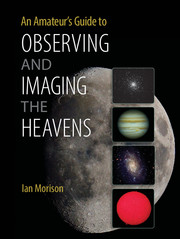Book contents
- Frontmatter
- Dedication
- Contents
- Preface
- Acknowledgements
- Prologue A Tale of Two Scopes
- 1 Telescope and Observing Fundamentals
- 2 Refractors
- 3 Binoculars and Spotting Scopes
- 4 The Newtonian Telescope and Its Derivatives
- 5 The Cassegrain Telescope and Its Derivatives
- 6 Telescope Maintenance, Collimation and Star Testing
- 7 Telescope Accessories
- 8 Telescope Mounts
- 9 The Art of Visual Observing
- 10 Visual Observations of the Moon and Planets
- 11 Imaging the Moon and Planets
- 12 Observing and Imaging the Sun
- 13 Observing and Imaging with an Astro-Video Camera
- 14 DSLR Deep-Sky Imaging
- 15 Imaging with Cooled CCD Cameras
- 16 Auto-Guiding and Drift Scan Alignment
- 17 Spectral Studies
- 18 Improving and Enhancing Images in Photoshop
- Index
- Plate Section
12 - Observing and Imaging the Sun
Published online by Cambridge University Press: 05 June 2014
- Frontmatter
- Dedication
- Contents
- Preface
- Acknowledgements
- Prologue A Tale of Two Scopes
- 1 Telescope and Observing Fundamentals
- 2 Refractors
- 3 Binoculars and Spotting Scopes
- 4 The Newtonian Telescope and Its Derivatives
- 5 The Cassegrain Telescope and Its Derivatives
- 6 Telescope Maintenance, Collimation and Star Testing
- 7 Telescope Accessories
- 8 Telescope Mounts
- 9 The Art of Visual Observing
- 10 Visual Observations of the Moon and Planets
- 11 Imaging the Moon and Planets
- 12 Observing and Imaging the Sun
- 13 Observing and Imaging with an Astro-Video Camera
- 14 DSLR Deep-Sky Imaging
- 15 Imaging with Cooled CCD Cameras
- 16 Auto-Guiding and Drift Scan Alignment
- 17 Spectral Studies
- 18 Improving and Enhancing Images in Photoshop
- Index
- Plate Section
Summary
A Warning
Before describing how to observe and image the Sun, I must give the standard warning. The Sun is the only astronomical object that could cause harm to an observer. If any observing aid, binocular or telescope is used to directly observe the Sun without the use of suitable solar filters, the retina can be irreparably damaged, leaving a blind spot or worse. It is not so much the visible light as the infrared radiation that is the problem. So if a filter is used, perhaps to observe a partial solar eclipse, it is vital that it be opaque to infrared. Any filter used to observe the Sun must be specifically designed for this use and it must be one that will totally block the infrared emission whilst bringing the visible light down to safe levels.
When the Sun is observed (and very great care is taken to use appropriate filters!) it appears to have a sharp edge but there is, of course, no actual surface. We are, in fact, just seeing down through the solar atmosphere to a depth where the gas becomes what is called ‘optically thick’. This deepest visible layer of the atmosphere is called the ‘photosphere’ (as this is where the photons that we see originate) and is about 500 km thick (Figure 12.1). The effective temperature of the photosphere is ~5,800 K. The convective transport of energy from below gives rise to a mottling of the surface − solar granulations that are about 1,000 km across. Each granulation cell lasts about 5–10 minutes as hot gas, having risen from below the surface, radiates energy away, cools and sinks down again.
- Type
- Chapter
- Information
- An Amateur's Guide to Observing and Imaging the Heavens , pp. 203 - 218Publisher: Cambridge University PressPrint publication year: 2014



